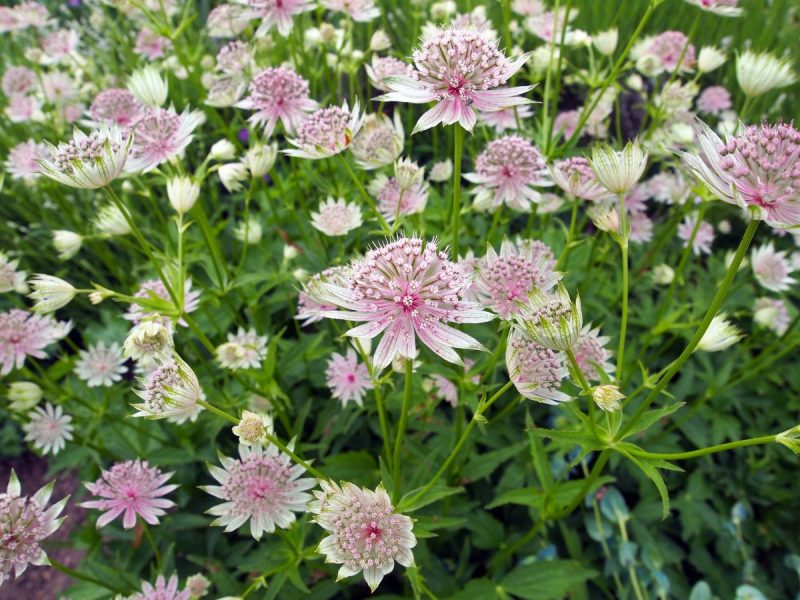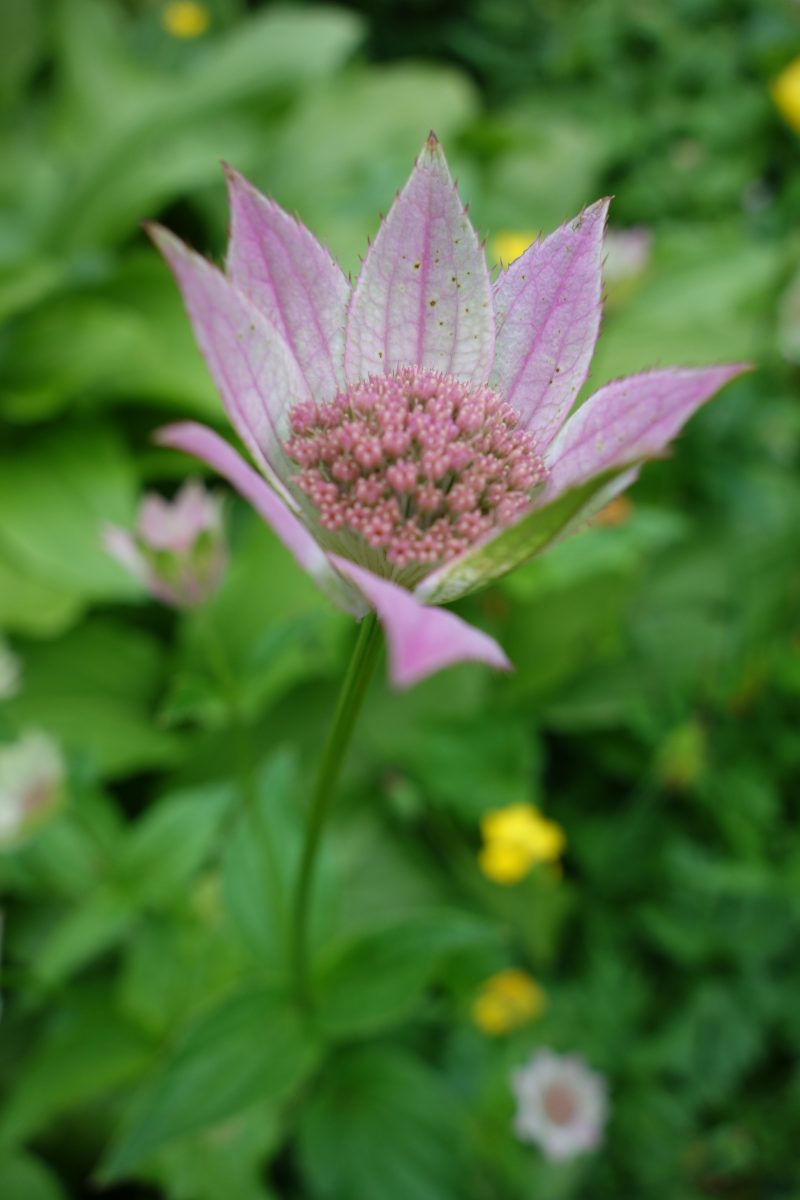Great masterwort, planting guide and care work

Great masterwort (Astrantia major) is a perennial herbaceous plant that belongs to the Astrantia genus, to the Apiaceae family (carrot family), and it is native to Europe and Western Asia. Great masterwort is often found on mountain meadows, pastures and in the forest area, but it can also be cultivated in the garden, next to curbs or in parks. They can also be used in floral arrangements or as cut flowers. It stands out for the uniqueness of its flowers, similar to pincushions. The inflorescence is made up of a dense umbel, composed of small greenish-white, pink or red flowers, surrounded by bracts, similar to petals. It blooms from late spring to early summer. The leaves are also decorative. These are palmately lobed (slightly similar to those of maple) and grow at the base of the stem.
Great masterwort – varieties and cultivars
- ‘Abbey Road’: vigorous plants, often used as cut flowers. The leaves are large, and the flowers are purple, supported by dark stems. Unlike other varieties, it tolerates drier environmental conditions;
- “Buckland’: it blooms early, having pink flowers, surrounded by green-silver bracts;
- ‘Hadspen Blood’: vigorous plants, with dark red flowers, supported by tall, dark stems;
- “Moulin Rouge’: it has red, pointed bracts with a dark tip, which surround ruby-red flowers;
- ‘Roma’: with pink flowers and pink-silver bracts.



Environmental conditions
Light. It prefers shaded places, but it can also tolerate the sun in the first part of the day. In areas with cool summers, it can also be cultivated in sunnier places.
Temperature. It grows and develops well in cooler climates. In case of low temperatures, it is recommended to mulch the soil around the plants, to protect the roots from freezing.
Soil. It grows well on soils rich in organic matter, well drained, moist. It does not tolerate too dry soils, and, therefore, in dry periods, regular watering is recommended to keep the soil damp.
Great masterwort – care
Watering. It is watered regularly, especially in conditions of high temperatures and drought. The lack of moisture in the soil during the summer can lead to the depreciation of the leaves (stiff, brittle leaves) and the lack of flowers.
Fertilizing. For optimal growth, plants are fertilized regularly during the growing season. Fertilizers specially formulated for flowering plants can be used.
Recommended products
-
You can find products on a different store
Change Store -
You can find products on a different store
Change Store -
You can find products on a different store
Change Store -
You can find products on a different store
Change Store -
You can find products on a different store
Change Store -
You can find products on a different store
Change Store -
You can find products on a different store
Change Store -
You can find products on a different store
Change Store -
You can find products on a different store
Change Store -
You can find products on a different store
Change Store -
You can find products on a different store
Change Store -
You can find products on a different store
Change Store -
You can find products on a different store
Change Store -
You can find products on a different store
Change Store -
You can find products on a different store
Change Store -
You can find products on a different store
Change Store -
You can find products on a different store
Change Store -
You can find products on a different store
Change Store -
You can find products on a different store
Change Store -
You can find products on a different store
Change Store -
You can find products on a different store
Change Store -
You can find products on a different store
Change Store -
You can find products on a different store
Change Store -
You can find products on a different store
Change Store
Pruning. To extend the flowering period, it is recommended to cut the dried flowers. After the end of the growing season (in autumn), the plants can be cut close to the ground.
Recommended products
-
You can find products on a different store
Change Store -
You can find products on a different store
Change Store -
You can find products on a different store
Change Store -
You can find products on a different store
Change Store -
You can find products on a different store
Change Store -
You can find products on a different store
Change Store -
You can find products on a different store
Change Store -
You can find products on a different store
Change Store -
You can find products on a different store
Change Store -
You can find products on a different store
Change Store -
You can find products on a different store
Change Store -
You can find products on a different store
Change Store -
You can find products on a different store
Change Store -
You can find products on a different store
Change Store -
You can find products on a different store
Change Store -
You can find products on a different store
Change Store -
You can find products on a different store
Change Store -
You can find products on a different store
Change Store -
You can find products on a different store
Change Store -
You can find products on a different store
Change Store -
You can find products on a different store
Change Store -
You can find products on a different store
Change Store -
You can find products on a different store
Change Store -
You can find products on a different store
Change Store
Propagation. Great masterwort is propagated by dividing the bush or by seeds. Propagation by dividing the bush can be done in spring, but also at the beginning of autumn. When propagating by seeds, in order for them to germinate, they need to be layered at low temperatures for 1-2 months. The new seedlings can be planted in the garden in early spring (after the last expected frost) or at the beginning of autumn.
Diseases and pests
Great masterwort is susceptible to powdery mildew. Among the pests, it can be attacked by snails or slugs, aphids and borers.
Recommended products
-
You can find products on a different store
Change Store -
You can find products on a different store
Change Store -
You can find products on a different store
Change Store -
You can find products on a different store
Change Store -
You can find products on a different store
Change Store -
You can find products on a different store
Change Store -
You can find products on a different store
Change Store -
You can find products on a different store
Change Store -
You can find products on a different store
Change Store -
You can find products on a different store
Change Store -
You can find products on a different store
Change Store -
You can find products on a different store
Change Store -
You can find products on a different store
Change Store -
You can find products on a different store
Change Store -
You can find products on a different store
Change Store -
You can find products on a different store
Change Store -
You can find products on a different store
Change Store -
You can find products on a different store
Change Store -
You can find products on a different store
Change Store -
You can find products on a different store
Change Store -
You can find products on a different store
Change Store -
You can find products on a different store
Change Store -
You can find products on a different store
Change Store -
You can find products on a different store
Change Store
Recommended products
-
You can find products on a different store
Change Store -
You can find products on a different store
Change Store -
You can find products on a different store
Change Store -
You can find products on a different store
Change Store -
You can find products on a different store
Change Store -
You can find products on a different store
Change Store -
You can find products on a different store
Change Store -
You can find products on a different store
Change Store -
You can find products on a different store
Change Store -
You can find products on a different store
Change Store -
You can find products on a different store
Change Store -
You can find products on a different store
Change Store -
You can find products on a different store
Change Store -
You can find products on a different store
Change Store -
You can find products on a different store
Change Store -
You can find products on a different store
Change Store -
You can find products on a different store
Change Store -
You can find products on a different store
Change Store -
You can find products on a different store
Change Store -
You can find products on a different store
Change Store -
You can find products on a different store
Change Store -
You can find products on a different store
Change Store -
You can find products on a different store
Change Store -
You can find products on a different store
Change Store
Additionally:
- The name of the Astrantia genus derives from the Latin “aster”, which translates as “star”, referring to the shape of the flower bracts;
- Usually, the bracts remain decorative even after the flowers wither, being a good choice for floral arrangements;
- The plant can also be grown in flowerpots, but it needs protection during the winter if it is kept outside.















































































































































































































































































































































































































































